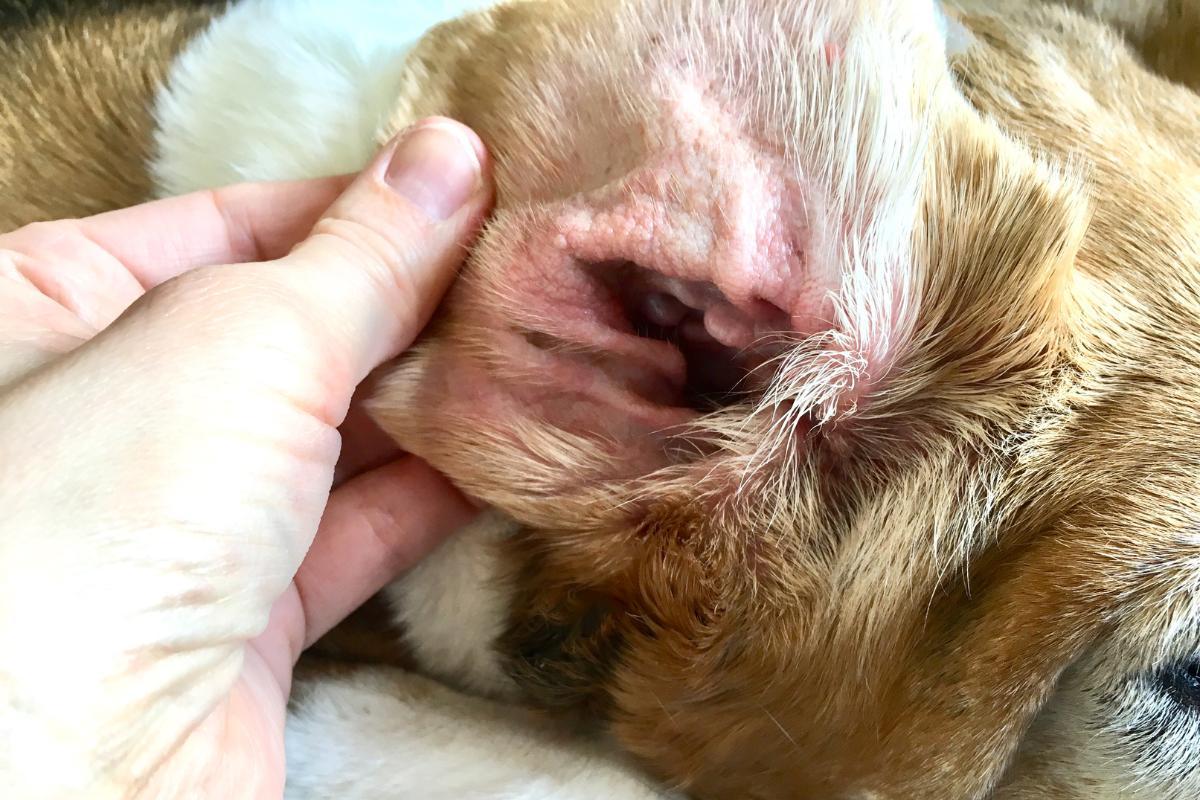My Dog's Ears Are Red and Itchy



See files for Dogs
A dog's ears are one of the most sensitive areas of their body. For hearing to occur, the muscles and tissues which make up the ear are very sensitive. Being extremities, they are more exposed to the external environment. This includes the elements, such as the rain, wind and cold. They are also exposed to pathogens and parasites, both of which can result in the ear becoming red due to pain and inflammation. Although ear redness in dogs can be due to mild causes, it is very important never to ignore this symptom. Due to the sensitivity of these organs, even mild problems can worsen over time and result in complications such as deafness.
AnimalWised looks why my dog's ears are red and itchy. We look at the various causes and treatment options which are available to both relieve discomfort and prevent serious problems in the future.
Otitis
Otitis is a general term for inflammation of the ear. It can be both external or internal, depending on the ear tissues which are most affected. The inflammatory processes which can result in otitis also cause the ear to turn various levels of red and become itchy. This is due to the body's immune response targeting the problem and trying to remedy it. In addition to redness and swelling, the dog can experience pain and discomfort.
Although otitis is a common reason why a dog's ears are red and itchy, this does not mean it can be ignored. If not treated in time, it can result in serious problems, including hearing loss. The common causes of otitis in dogs include the following:
- Infections: often due to fungi or bacteria, since the ears provide the optimal warm and humid environment for these pathogens. Breeds with drooping ears are more likely to contract this problem. Although less common, viral diseases such as those caused by canine herpesvirus can result in aural redness[1].
- Allergies: whether due to food or environmental allergens, a dog's red ears can be due to an allergic reaction. Whether due to allergies or other irritants, contact dermatitis is a common cause of ear redness in dogs.
- Foreign bodies: since the ears of a dog are so exposed, they can come in contact with sharp materials that can become embedded in the skin of the ear. Smaller foreign bodies can even lodge inside the ear canal.
- Ear mites: these are very small arachnids which can be present in limited numbers can cause no obvious symptoms. However, when the mites proliferate, inflammation and redness may occur. This is often influenced by a lowered immune system.
- Excessive humidity: for example, when a dog swims in water very frequently, the humid environment can lead to a greater chance of infection or infestation.
In addition to any redness, a dog may scratch at their ears excessively to relieve accompanying pain or itchiness caused by otitis in dogs. This can worsen the otitis and result in secondary infections or other problems. For this reason, we may need to prevent access to the ears with the use of an Elizabethan collar or similar restraint.
What to do if a dog has otitis
If you suspect your dog has otitis, it is best to consult your veterinarian to obtain a diagnosis. They can best determine whether treatment is necessary. Treatment may require medication such as antibiotics, painkillers or ear drops such as Conofite for dogs. It is also important to properly clean your dog's ears with specific products.
In the video below, we explain how to clean your dog's ears :

Allergies
We have already explained that a dog's ear can become red and itchy due to otitis. We should know this is a medical condition, but not a specific disease. It is caused by various health issues which we discuss in greater detail here.
Allergies are a common type of skin disease in dogs and a common reason why a dog's ears are red. When the skin reacts to an allergen, an immune system response occurs. This response usually causes inflammation and redness. This immune response does not occur in dogs which do not have a sensitivity to the given allergen.
Since a dog's ears are extremities, they can often come in contact with allergens which affect them topically. For example, if they run through foliage to which they have an allergy, only their ears may come in contact with the allergen. A dog's ears can also become red and itchy if they have an allergic response to food or something else they ingest. In the latter case, it is likely that other parts of their body will also exhibit redness.
Dogs can also have allergic reactions to chemicals found in their environment. Examples include the detergent you use to wash their bedding or even the material from which their collar is made. When sufficiently severe, the allergy can cause the skin to break and purulent discharge.
What to do if a dog has allergies
If your veterinarian confirms an allergy to a specific element, you will need to limit their exposure as much as possible. This is easier to do with some allergies more than others. For example, if they have a food allergy, you can simply remove it from their diet. If they have an allergy to pollen, this can be harder to control. When you go to the veterinarian, they may prescribe antihistamines or other drugs to control allergies.
Mites
The appearance of mites in the ears of dogs is quite common. This is especially so in puppies and dogs that are in direct contact with other animals. These parasites lodge in the ear canal. While they may be asymptomatic in small numbers, they cause intense irritation and inflammation when sufficiently prolific.
Symptoms of mites in dogs include redness in the dog's ear, itching, hair loss and dark discharge. It is also common for a dog to have red ears that smell bad due to the mites feeding on dead skin cells, blood and other secretions. They produce waste from these materials which can create a foul odor.
One of the mites that most commonly affect a dog's ears is Otodectes cynotis, a mite which causes otodectic mange. Another is Demodex canis which causes demodectic mange in dogs. These can be very serious skin diseases which will spread to other areas of the body.
What to do if my dog has ear mites
To get rid of ear mites in a dog, your veterinarian will recommend the following treatments:
- There are specific drops for the ears and they should be applied following the instructions of the vet.
- Careful cleaning of the ear canal to remove wax and any debris.
- Administering an antiparasitic medication is especially important, since it will be the only treatment that will definitively end the problem.
- Make sure the problem has been resolved to prevent relapses, as mites can sometimes reappear if not completely eradicated.
Mites are very contagious, so it is vitally important to keep your dogs away from other animals while being treated. Some of them are also contagious to humans, so we need to be careful ourselves. Establish a suitable deworming schedule for the dog so that we can best prevent their appearance in the future.
Trauma or wounds
Another reason your dog may have red and itchy ears is due to wounds caused by a a foreign object or particle getting into their ear. As a result, the dog scratches a lot and rubs against surfaces to relieve the irritation on their skin. If a wound occurs, you will see the presence of blood or scabs, depending on the stage of the healing process.
You dog may also receive trauma from other sources. If they are running in a wood, the sharp points of branches can cause a wound. During fights with other dogs, it is common for the animals to attack each others ears. This can even occur if playfighting becomes too rough, a reason why proper socialization of dogs is so important.
What to do if my dog has ear wounds
When we see a wound on the dog's ear, we should disinfect the lesion with a trusted product such as chlorhexidine. In some cases, antibiotics may be necessary to prevent a more serious infection or treat one if it already exists. If your dog scratches a lot, the use of an Elizabethan collar may be necessary to prevent access to the ears until the wound is healed.

Foreign bodies
Foreign bodies such as thorns, seeds, dirt, insects or any other particle can enter your dog's ear canal. This can cause a lot of discomfort. In this case, the dog's ears become red and itchy due to irritation in the skin. In these situations, it is possible to notice that the dog shakes their head constantly to try to expel the foreign body.
Especially if the dog's ears are hot, the redness cam be a symptom of serious irritation. This is especially so if the outer ear is not inflamed, but the problem seems to be more internal. Dirt and pathogens can accumulate around the foreign body and the physical movement can cause further irritation.
What to do if a dog has a foreign body in their ear
It will be necessary to remove the foreign object that has lodged in the ear cavity. This is something which must ve carried out by the veterinarian. If the object is lodged in an area that is difficult to access, trying to remove the foreign yourself can cause damage to the sensitive structures of the ear.
After removing the foreign body, the ear will need to be cleaned to remove any remaining debris and reduce the risk of infection. In addition, the use of antibiotics and anti-inflammatories may be recommended, as well as preventing your dog from scratching with a collar.
As you can see, red ears in dogs have multiple causes and all of them require veterinary attention. If you see a specific lump in the ear, it may be due to an accumulation of fluid. Learn more about one cause with our article on aural hematoma in dogs.

This article is purely informative. AnimalWised does not have the authority to prescribe any veterinary treatment or create a diagnosis. We invite you to take your pet to the veterinarian if they are suffering from any condition or pain.
If you want to read similar articles to My Dog's Ears Are Red and Itchy, we recommend you visit our Other health problems category.
1. Evermann, J. F., Ledbetter, E. C., & Maes, R. K. (2011). Canine reproductive, respiratory, and ocular diseases due to canine herpesvirus. The Veterinary clinics of North America. Small animal practice, 41(6), 1097–1120.
https://doi.org/10.1016/j.cvsm.2011.08.007






